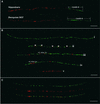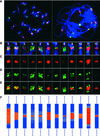Functional rice centromeres are marked by a satellite repeat and a centromere-specific retrotransposon
- PMID: 12172016
- PMCID: PMC151459
- DOI: 10.1105/tpc.003079
Functional rice centromeres are marked by a satellite repeat and a centromere-specific retrotransposon
Abstract
The centromere of eukaryotic chromosomes is essential for the faithful segregation and inheritance of genetic information. In the majority of eukaryotic species, centromeres are associated with highly repetitive DNA, and as a consequence, the boundary for a functional centromere is difficult to define. In this study, we demonstrate that the centers of rice centromeres are occupied by a 155-bp satellite repeat, CentO, and a centromere-specific retrotransposon, CRR. The CentO satellite is located within the chromosomal regions to which the spindle fibers attach. CentO is quantitatively variable among the 12 rice centromeres, ranging from 65 kb to 2 Mb, and is interrupted irregularly by CRR elements. The break points of 14 rice centromere misdivision events were mapped to the middle of the CentO arrays, suggesting that the CentO satellite is located within the functional domain of rice centromeres. Our results demonstrate that the CentO satellite may be a key DNA element for rice centromere function.
Figures






Similar articles
-
The transcribed 165-bp CentO satellite is the major functional centromeric element in the wild rice species Oryza punctata.Plant Physiol. 2005 Sep;139(1):306-15. doi: 10.1104/pp.105.064147. Epub 2005 Aug 19. Plant Physiol. 2005. PMID: 16113220 Free PMC article.
-
Identification and diversity of functional centromere satellites in the wild rice species Oryza brachyantha.Chromosome Res. 2013 Dec;21(8):725-37. doi: 10.1007/s10577-013-9374-8. Chromosome Res. 2013. PMID: 24077888
-
Chromatin immunoprecipitation cloning reveals rapid evolutionary patterns of centromeric DNA in Oryza species.Proc Natl Acad Sci U S A. 2005 Aug 16;102(33):11793-8. doi: 10.1073/pnas.0503863102. Epub 2005 Jul 22. Proc Natl Acad Sci U S A. 2005. PMID: 16040802 Free PMC article.
-
Rice genome organization: the centromere and genome interactions.Ann Bot. 2002 Oct;90(4):427-35. doi: 10.1093/aob/mcf218. Ann Bot. 2002. PMID: 12324265 Free PMC article. Review.
-
Tandemly repeated DNA sequences and centromeric chromosomal regions of Arabidopsis species.Chromosome Res. 2003;11(3):241-53. doi: 10.1023/a:1022998709969. Chromosome Res. 2003. PMID: 12769291 Review.
Cited by
-
Analysis of the epigenetic status of telomeres by using ChIP-seq data.Nucleic Acids Res. 2012 Nov;40(21):e163. doi: 10.1093/nar/gks730. Epub 2012 Aug 1. Nucleic Acids Res. 2012. PMID: 22855559 Free PMC article.
-
Meiosis in crops: from genes to genomes.J Exp Bot. 2021 Sep 30;72(18):6091-6109. doi: 10.1093/jxb/erab217. J Exp Bot. 2021. PMID: 34009331 Free PMC article. Review.
-
Where does the accurate rice genome sequence lead us?Plant Mol Biol. 2005 Sep;59(1):27-32. doi: 10.1007/s11103-005-1224-4. Plant Mol Biol. 2005. PMID: 16217599 No abstract available.
-
Non-homologous chromosome pairing and crossover formation in haploid rice meiosis.Chromosoma. 2011 Feb;120(1):47-60. doi: 10.1007/s00412-010-0288-3. Epub 2010 Aug 13. Chromosoma. 2011. PMID: 20706730
-
Centric fission--simple and complex mechanisms.Chromosome Res. 2004;12(6):627-40. doi: 10.1023/B:CHRO.0000036594.38997.59. Chromosome Res. 2004. PMID: 15289668 Review.
References
-
- Arabidopsis Genome Initiative. (2000). Analysis of the genome sequence of the flowering plant Arabidopsis thaliana. Nature 408, 796–815. - PubMed
-
- Aragon-Alcaide, L., Miller, T., Schwarzacher, T., Reader, S., and Moore, G. (1996). A cereal centromeric sequence. Chromosoma 105, 261–268. - PubMed
-
- Arumuganathan, K., and Earle, E.D. (1991). Nuclear DNA content of some important plant species. Plant Mol. Biol. Rep. 9, 208–218.
Publication types
MeSH terms
Substances
Associated data
- Actions
LinkOut - more resources
Full Text Sources
Other Literature Sources
Miscellaneous

